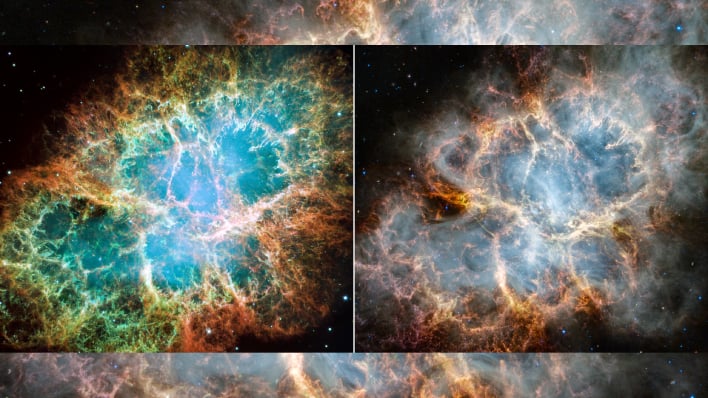NASA Telescope Zooms In On A Crab Nebula, The Haunted Remains Of An Exploded Star
NASA’s James Webb Space Telescope captured an enlightening image of the Crab Nebula, a supernova remnant that is located 6,500 light-years from Earth. The Crab has been studied since as far back as 1054 CE by 11th-century astronomers.
The top image is a side-by-side comparison of the Crab Nebula as seen by the Hubble Space Telescope in optical light (left) and Webb in infrared light (right) that reveals different details of the Crab. Astronomers are able to take different views from telescopes like Webb and Hubble to build a better understanding of the supernova remnant. The image Webb captured emission from dust grains (yellow-white and green) for the first time.
"Webb’s sensitivity and spatial resolution allow us to accurately determine the composition of the ejected material, particularly the content of iron and nickel, which may reveal what type of explosion produced the Crab Nebula," remarked Tea Temim, team lead of the recent study.
Another aspect of the Crab Nebula that Webb was able to highlight was the inner workings of the nebula that become more apparent and are in greater detail than seen by Hubble. NASA says that in particular, Webb is able to view what is known as synchrotron radiation. This is emission produced from charged particles like electrons which are moving around magnetic field lines at relativistic speeds. The radiation can be seen as milky smoke-like material throughout Webb’s image.
The space agency says that the wind produced by the pulsar heart continues to push the shell of gas and dust outward at an extreme pace. The interior of the remnant, seen as yellow-white and green-mottled filaments, represents areas where the dust grains are located.
Astronomers and scientists will continue exploring the Crab Nebula with Webb and other telescopes to further investigate the supernova remnant. Hubble will be utilized to peer at the emission lines from the Crab Nebula for the first time in over 20 years.
The top image is a side-by-side comparison of the Crab Nebula as seen by the Hubble Space Telescope in optical light (left) and Webb in infrared light (right) that reveals different details of the Crab. Astronomers are able to take different views from telescopes like Webb and Hubble to build a better understanding of the supernova remnant. The image Webb captured emission from dust grains (yellow-white and green) for the first time.
"Webb’s sensitivity and spatial resolution allow us to accurately determine the composition of the ejected material, particularly the content of iron and nickel, which may reveal what type of explosion produced the Crab Nebula," remarked Tea Temim, team lead of the recent study.
Another aspect of the Crab Nebula that Webb was able to highlight was the inner workings of the nebula that become more apparent and are in greater detail than seen by Hubble. NASA says that in particular, Webb is able to view what is known as synchrotron radiation. This is emission produced from charged particles like electrons which are moving around magnetic field lines at relativistic speeds. The radiation can be seen as milky smoke-like material throughout Webb’s image.
The space agency says that the wind produced by the pulsar heart continues to push the shell of gas and dust outward at an extreme pace. The interior of the remnant, seen as yellow-white and green-mottled filaments, represents areas where the dust grains are located.
Astronomers and scientists will continue exploring the Crab Nebula with Webb and other telescopes to further investigate the supernova remnant. Hubble will be utilized to peer at the emission lines from the Crab Nebula for the first time in over 20 years.


